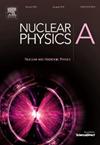Isospin dependence of shell closure at N = 90 and 92 for medium mass nuclei using relativistic energy density functional
IF 2.5
4区 物理与天体物理
Q2 PHYSICS, NUCLEAR
引用次数: 0
Abstract
In a recent study [Europhys. Lett. 146, (2024), 14001], a novel relativistic parameterisation of the energy density functional (EDF) at local density was integrated into the coherent density fluctuation model (CDFM). This approach employed the density-dependent DD-ME2 parameter within the relativistic Hartree-Bogoliubov framework, alongside the well-established non-linear NL3 force parameter, to investigate the surface properties of a few doubly-magic nuclei. In the present work, we extend this new relativistic EDF formulation to a much broader region: the evolution of shell structure across several open- and closed-shell nuclei of intermediate-mass isotopic chains, specifically Kr (), Sr (), Te (), Xe (), Ba (), Ce (), Nd () and Sm (). Using the CDFM formalism, we translate key nuclear matter quantities, such as the symmetry energy and its derivatives, from momentum space to coordinate space at local densities. This procedure is particularly relevant when investigating nuclei near the drip lines. Our findings demonstrate that the symmetry energy successfully reproduces the conventional magic numbers and 82 while indicating the emergence of new shell and/or sub-shell closures around and 92. Furthermore, we decompose the symmetry energy into its volume and surface components, using two approaches, and perform an extensive comparison to assess their impact on the identification of shell closures. We also examine how neutron-proton asymmetry influences the symmetry energy along these isotopic chains. In general, this study highlights novel regions of interest in the medium-mass region of the nuclear chart. It emphasises the need for experimental investigations of the newly suggested shell closures.
利用相对论能量密度泛函研究中等质量原子核在N = 90和92时壳层闭合的同位旋依赖性
在最近的一项研究中[欧洲物理学]。leet . 146,(2024), 14001],将局部密度下能量密度泛函(EDF)的一种新的相对论参数化集成到相干密度涨落模型(CDFM)中。该方法采用了相对论Hartree-Bogoliubov框架中密度相关的DD-ME2参数,以及已建立的非线性NL3力参数,来研究一些双魔核的表面性质。在目前的工作中,我们将这个新的相对论EDF公式扩展到更广泛的区域:跨几个中等质量同位素链的开壳核和闭壳核的壳结构演化,特别是Kr (Z=36)、Sr (Z=38)、Te (Z=52)、Xe (Z=54)、Ba (Z=56)、Ce (Z=58)、Nd (Z=60)和Sm (Z=62)。利用CDFM的形式,我们将关键的核物质量,如对称能量及其导数,从动量空间转换到局部密度下的坐标空间。当研究滴注管附近的核时,这种方法尤其适用。我们的研究结果表明,对称能成功地再现了传统的幻数N=50和82,同时表明在N=90和92附近出现了新的壳和/或子壳闭包。此外,我们使用两种方法将对称能分解为其体积和表面分量,并进行了广泛的比较,以评估它们对壳包体识别的影响。我们还研究了中子-质子不对称如何影响这些同位素链上的对称能。总的来说,这项研究突出了核图中质区感兴趣的新区域。它强调需要对新建议的封壳进行实验调查。
本文章由计算机程序翻译,如有差异,请以英文原文为准。
求助全文
约1分钟内获得全文
求助全文
来源期刊

Nuclear Physics A
物理-物理:核物理
CiteScore
3.60
自引率
7.10%
发文量
113
审稿时长
61 days
期刊介绍:
Nuclear Physics A focuses on the domain of nuclear and hadronic physics and includes the following subsections: Nuclear Structure and Dynamics; Intermediate and High Energy Heavy Ion Physics; Hadronic Physics; Electromagnetic and Weak Interactions; Nuclear Astrophysics. The emphasis is on original research papers. A number of carefully selected and reviewed conference proceedings are published as an integral part of the journal.
 求助内容:
求助内容: 应助结果提醒方式:
应助结果提醒方式:


